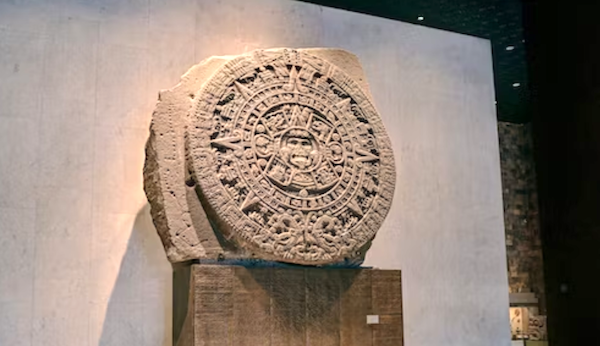Inca and Aztec Temple Hieroglyphics: Their Influence on Space Knowledge
By Space Coast Daily // February 21, 2024
Many ancient cultures interest archaeologists, astronomers, anthropologists and linguists. Some of the most interesting cultures are the ones we know the least about. It includes the Inca and Aztec civilisations. However, what information we do know made a massive impact on our understanding of these cultures and astronomy.
Influence of Aztec Hieroglyphics
Anthropologists overlooked Aztec hieroglyphics for many years. Many academics believed this written language didn’t constitute a comprehensive language. As such, they frequently discarded its significance.
Aztec Influences on Modern Society
First, let’s look at some parts of this civilisation we can find in contemporary society. The Aztecs are most known for their incredible architecture.
Most people can’t imagine building these structures without our modern technology. Many conspiracy theories exist about how aliens visited Aztecs or used technology from outer space to construct their cities.
The architecture frequently appears in modern pop culture and games. It even makes an appearance in casino slots like Temple Tumble Megaways. Further, places in Mexico sometimes still have names that originate from the Aztec language. Examples are San Bernardino Contla, Texcoco, and San Martín Cuautlalpan.
Loss of Aztec Library
Part of the reason many didn’t consider the Aztec hieroglyphics to be a comprehensive language is the limited resources. The Spanish conquistadores obliterated the Aztec libraries in Tenochtitlan, Tetzcoco, and Tlacopan.
Due to the destruction of these libraries, almost no text survived from this period. As such, it was challenging to determine the extent of the written language. Only one or two books survived the destruction. Aztec descendants later wrote around 30 more books in these hieroglyphics.
As such, there are limited reliable texts left over from this period, as it was all erased during the conquest. It could have been one of the world’s greatest libraries, but it’s now essentially erased from history.
Detailed Language
Still, not everyone had given up on deciphering the mysteries of the Aztec’s written language. Gordon Whittaker, a British linguist anthropologist, published research in 2021 that showed academics worldwide have been missing something.
By studying the texts, mainly the ones written after the conquest, he discovered that the written language was a detailed script that could deliver every syllable of the Aztec language, Nahuatl. As such, the civilisation could use these hieroglyphs to phonetically express sounds and name places, items, names, and tens of thousands of other words.
Unfortunately, this discovery was made too late, and too few texts exist for it to help the modern understanding of space. However, if we consider the famous Aztec Calendar Stone, it’s safe to say their original texts might have taught us much about their understanding of space.
Calendar Stone
The Calendar Stone, also called the Sun Stone, is a massive construction about 12 feet across and three feet thick stone used. It weighs about 22.5 tonnes, and the Aztecs carved it from basalt. Over time, it got buried, and eventually, Mexico City was built over it. It was only in 1790 that workers uncovered this structure, and people gained a renewed interest in Mexico’s culture.
The Calendar Stone revealed that Aztecs used a calendar system close to the modern one we use today. Like our current calendar, the Xiuhpohualli calendar had 365 days and four seasons. However, the months were only 20 days long, which means there were about 18 months. They also added five unlucky days, bringing their total days in a year to 365.
Further, they also followed another sacred calendar, Tonalpohualli, which had 260 days. The priests mainly used this calendar to determine lucky days for going to war, planting crops, and other activities. Every 52 years, these Calendars would align, and it could mean the end of the world.
Does the Inca Have a Written Language?
Another culture we look at is the Inca. However, unlike the Aztecs, the Incas had no written language. While the Inca were revolutionary in their hanging rope bridges, called the Keshwa-chaka, they didn’t translate their language into a written one.
Quipus
The Inca had a system different from the written language called the Quipus. This “language” is closer to computer programming, consisting of knotted strings. The number of knots on a string, the total strings in a set, and even the colour conveyed a message. Its purpose is similar to an abacus but using a more complicated system.
The Inca used this tool as a memory aid to keep track of inventory in storehouses. However, it had no real influence on our understanding of space. All it did was show their excellent organisational skills, advanced counting systems and mathematics.
Other Similar Ancient Cultures
The Mayans are the other culture often brought up alongside the Inca and Aztecs. The Mayans completed in-depth space studies, observing the stars and planets like Venus in detail. They kept clear records of their astronomy findings, as they believed it was messages from gods.
They tracked planets in the solar system, such as Jupiter, Mars, Venus, and Saturn, without any technology we use for modern space imaging.
This civilisation was the epitome of astronomers whose calendar predicted the world’s end. For many years, people believed the Mayans predicted the world would end in December 2012. It caused many movies about it, such as Seeking a Friend for the End of the World, Take Shelter, and, famously, the 2012 movie.
What We Know Today
Looking back at what ancient Aztec temple hieroglyphics said, it’s clear that they had a comprehensive understanding of astronomy. Their calendar is possibly the closest one to the modern calendar, and they had a detailed written language. However, we discovered much of this knowledge after implementing the Gregorian calendar.
By the time we learned of the vast knowledge the Aztecs and even Mayans had about space, we’d already discovered most of it again. These days, the most that Aztec hieroglyphs tell us about space are stories about a giant flint knife descending from the skies. This “knife” brought the gods to Earth, who then created humans in their image.
While this story falls into mythology instead of science, it’s a primary underlying reason for most conspiracy theories. Regardless of whether it’s true, we know that much of our knowledge about space today, the Aztecs, Incas, and Mayans, was already discovered hundreds of years ago.













